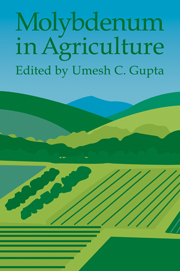Book contents
- Frontmatter
- Contents
- List of contributors
- Preface
- 1 Introduction
- 2 Chemistry and Mineralogy of Molybdenum in Soils
- 3 Distribution and Mobility of Molybdenum in the Terrestrial Environment
- 4 Biochemical Significance of Molybdenum in Crop Plants
- 5 Soil and Plant Factors Affecting Molybdenum Uptake by Plants
- 6 Analytical Techniques for Molybdenum Determination in Plants and Soils
- 7 Testing for Molybdenum Availability in Soils
- 8 Molybdenum Availability in Alkaline Soils
- 9 Deficient, Sufficient, and Toxic Concentrations of Molybdenum in Crops
- 10 Symptoms of Molybdenum Deficiency and Toxicity in Crops
- 11 Sources and Methods for Molybdenum Fertilization of Crops
- 12 Yield Responses to Molybdenum by Field and Horticultural Crops
- 13 Responses of Forage Legumes and Grasses to Molybdenum
- 14 Molybdenum and Sulfur Relationships in Plants
- 15 Molybdenum in the Tropics
- Index
13 - Responses of Forage Legumes and Grasses to Molybdenum
Published online by Cambridge University Press: 10 December 2009
- Frontmatter
- Contents
- List of contributors
- Preface
- 1 Introduction
- 2 Chemistry and Mineralogy of Molybdenum in Soils
- 3 Distribution and Mobility of Molybdenum in the Terrestrial Environment
- 4 Biochemical Significance of Molybdenum in Crop Plants
- 5 Soil and Plant Factors Affecting Molybdenum Uptake by Plants
- 6 Analytical Techniques for Molybdenum Determination in Plants and Soils
- 7 Testing for Molybdenum Availability in Soils
- 8 Molybdenum Availability in Alkaline Soils
- 9 Deficient, Sufficient, and Toxic Concentrations of Molybdenum in Crops
- 10 Symptoms of Molybdenum Deficiency and Toxicity in Crops
- 11 Sources and Methods for Molybdenum Fertilization of Crops
- 12 Yield Responses to Molybdenum by Field and Horticultural Crops
- 13 Responses of Forage Legumes and Grasses to Molybdenum
- 14 Molybdenum and Sulfur Relationships in Plants
- 15 Molybdenum in the Tropics
- Index
Summary
Introduction
In this chapter we consider the role of molybdenum (Mo) in the nutrition of legume and grass species cultivated to feed livestock, whether in the form of direct grazing in pastures or as plants cut and removed for use as fodder. It is recognized that crop residues and plant species other than legumes and grasses (e.g., brassicas) are important sources of livestock fodder worldwide and that Mo nutrition can markedly affect their production and quality, but this review is restricted to forage legumes and grasses. We concentrate mainly on legume responses to Mo, because a prime role for this element in plant growth is its involvement in the symbiotic process of nitrogen fixation (Chatt et al., 1969), although Mo imbalances in grasses have also been reported (e.g., Lipsett, 1975).
The probability of Mo deficiency generally increases with increasing soil acidity (Gupta and Lipsett, 1981), and thus we further focus toward legume responses to the Mo-deficiency component of the acid-soil syndrome. It is difficult to diagnose Mo deficiencies, largely because of the relatively small quantities of Mo required for normal plant functions, and thus there is a higher probability than for other elements that Mo deficiencies in legumes will remain undetected. Consequently, legume biomass production and additions of fixed nitrogen (N) to the soil often remain suboptimal. Thus, in this chapter we emphasize the importance of accurate diagnosis of Mo deficiency and suggest appropriate corrective measures for sustaining pastures and forage production.
- Type
- Chapter
- Information
- Molybdenum in Agriculture , pp. 202 - 228Publisher: Cambridge University PressPrint publication year: 1997
- 4
- Cited by



